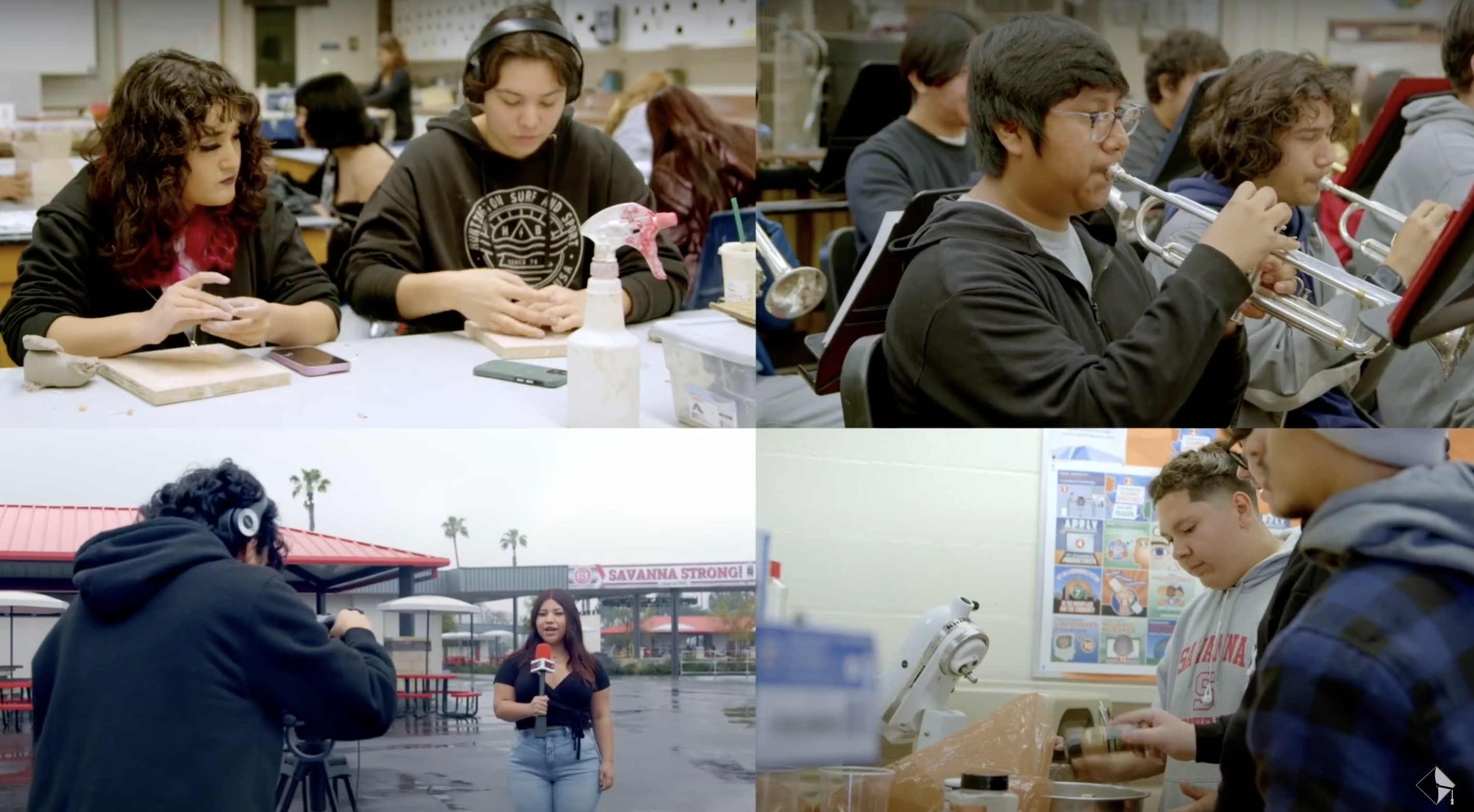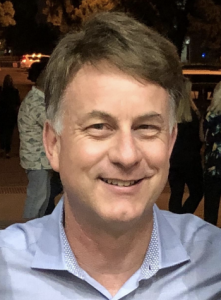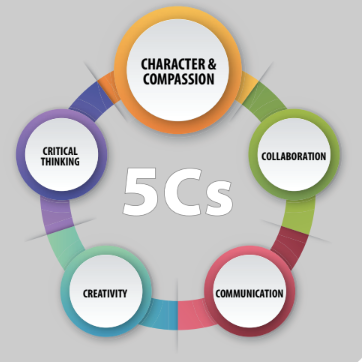The AUHSD Capstone Program:

Introduction
My teaching journey began in 1998 at Savanna High School, one of eight comprehensive high schools in the Anaheim Union High School District (AUHSD). During my first few years of teaching, the prevalent belief within the broader Anaheim Union High School District community was that success was synonymous with high test scores; and like many dedicated educators across the United States, my colleagues and I played the game dictated by standardized tests. In our collaborative efforts to plan curriculum, we analyzed the previous spring’s standardized exam, aligning standards to the test questions. A misaligned compass led us to prioritize the frequency of test strands over the richness of learning experiences. The more often that something appeared on the exam, the more class time we dedicated to drilling that specific content or skill. In our efforts to raise test scores, we inadvertently handcuffed ourselves to a narrow curriculum, a decision that ultimately resulted in more harm than good: We had structured a curriculum according to someone else’s belief system, from a perspective disconnected to our students and community. The dissonance led to a lack of relevance for our students and it robbed our teachers of agency essential to teacher success and fulfillment.
We also subscribed to the belief that frequent practice exams were a key to students’ success; thus, we created and administered regular benchmark exams that paralleled the spring assessments. I worked with a cohort of talented and caring teachers who wanted the best for our students. Yet, in hindsight, it is clear that we were operating under the wrong drivers. The culture we unintentionally created lacked authenticity, a sentiment felt by both educators and students alike; rather than providing students with genuine, relevant, and valuable learning experiences, teachers focused primarily on covering content and gaming the test. The benchmark exams were merely rehearsal exercises. Our approach was flawed — we didn’t analyze data to enhance the student learning experience; on the contrary, our primary motivation was the pursuit of higher test scores. Instead of addressing fundamental aspects of effective instruction, we chased superficial solutions to elevate test scores quickly. Our emphasis was on molding students into proficient test-takers rather than cultivating a learning environment rooted in curiosity and engagement.
Such was the culture at several schools in the AUHSD. District leadership was driven by high test scores, evident in the investment of software dedicated to generating interim assessments. Consequently, district collaboration time was consumed by the development of exams; rather than focusing on crafting meaningful and innovative learning experiences for our students, our energy was spent making tests.
Fast Forward to 2024
In 2024, teachers are no longer married to curriculum maps or pacing guides that evolved by counting test questions. Rather than following a single path based on someone else’s belief system, AUHSD teachers have written their own narratives that align to our own values and the needs of those we serve.
In 2024, we have found agency, autonomy, and joy.
In 2024, we have found agency, autonomy, and joy.
In 2024, every AUHSD school is implementing a Capstone Program grounded in 21st century skills, student voice, and technical skills. The Capstone Program — developed by each school as a means to operationalize their unique vision and values — outlines the ideal student experience for their school community. Anchored by a system of performance task assessments, each school’s Capstone creates the conditions for the community to learn and grow together.
In 2024, teachers are implementing Performance Task Assessments based on student interest and community needs. The line of proximity is tight: Students are studying and finding solutions for issues relevant to our own community such as food deserts, homelessness, climate change, and mental health.
In 2024, AUHSD teachers are studying new forms of data. The district is leveraging its unique Learning Management System, eKadence, along with artificial intelligence tools to collect data focused on emotional intelligence. Making use of these technologies allows us to collect real-time data on students, shifting away from conventional performance indicators that schools have relied on for decades. This street data, acquired through students’ reflections on their learning experiences, allows us to think beyond traditional learning skills and content knowledge. We continue to gain insights from traditional data sources. Our new data, though, is pushing us to think about teaching and learning in new ways. The data provides teachers with a more holistic, comprehensive understanding of students, encompassing their social and emotional well-being in addition to academic performance; it offers insights about students’ social intelligence, allowing teachers to consider ways to personalize supports and to adapt teaching strategies to better support students’ emotional needs; furthermore, the new data uncovers ways for teachers to support students in developing communication, collaboration, creativity, critical thinking, and character skills. In Anaheim, the 5Cs (collaboration, communication, creativity, critical thinking, compassion/kindness) have been a focus for several years, but gathering and making sense of meaningful data connected to these skills has long eluded the world of education. Led by our teachers, AUHSD is disrupting the traditional dashboard.
Savanna High School’s transformation began with a “visioning process” to reconsider the meaning of education and to determine what we wanted for our school community. Space was given for research, troubleshooting, and dialogue. While the entire process was valuable, most valuable was a collective commitment to newly created Student Learning Capacities (the SLCs would eventually morph into the district’s 5Cs). Teachers dedicated themselves to creating consistent and purposeful opportunities for students to practice 21st century skills – communication, collaboration, creativity, and critical thinking – that are relevant throughout life. To execute, and to move from poster to practice, from the website to the classroom, we knew we had to shift our practices. We knew we would not succeed playing the old game. To hold each other accountable, we developed a Capstone Program that centered the Student Learning Capacities in Performance Task Assessments. In 2012, I piloted the Capstone with three 12th grade English Language Arts classes. In 2013, all seniors at Savanna completed the Capstone. The following year, the project became a program and all Savanna students, grades 9-12, participated in the Savanna Capstone Program. We found success in the Capstone pilot, and teachers discovered a sense of empowerment that had been missing for years.
Look Back to 2021
In 2021, all twenty-one AUHSD schools began laying the groundwork for their own Capstone Programs.
Almost every district school participated in a similar visioning process as Savanna’s. Each school went on an extensive journey to reflect on its purpose and values. At each school, educational partners – teachers, students, parents, alumni, community members – were given a voice. Each school’s community envisioned what their school could become. They asked the questions: What do we value? What do we want our school to look like? Who do our students need us to be? Teams were provided space to research, write, share, and reflect on topics such as equity, identity, and instruction. Each school created an ethos that would inform its vision and values. Through the collaborative effort, communities became driven to embody these principles in their actions, shaping an educational experience that reflects the vision and enhances the learning journey for all students.
They asked the questions: What do we value? What do we want our school to look like? Who do our students need us to be?”
During the 2021-2022 school year, each AUHSD school began its own Capstone journey. Encouraged and led by the district’s Ed Division, each school leaned into its vision and values to create Capstone guidelines and structures unique to its own community. Teachers worked together to develop Performance Task Assessments and meaningful ways for students to reflect on their learning. Each school developed a Capstone Showcase structure to provide students a space to reflect on their learning to an authentic audience. At each school, the Capstone Showcase structure varies. While most schools have students share their learning experiences with a panel to spark engaging conversation, other schools opt for presentations of learning, mini Ted-talks, or even performances. The first year of implementation, 2022-2023, was a learning experience for schools and the district but, by all accounts, the initiative was a success.
In July 2022, AUHSD’s Ed Division published The Capstone Playbook to support each school’s rollout of its own Capstone Program. The playbook articulates the what, rationalizes the why, and advises how to launch a Capstone Program at a school. Through recommended timelines, suggested protocols and moves, and structures for internal accountability, the guide leads school communities to focus on a shared vision, establish a collaborative culture, learn together, and create systems of accountability. These conditions, as noted by Michael Fullan and Joanne Quinn, position schools to thrive (1).
The Capstone Playbook outlines a multi-year implementation plan that positions teachers and the school community members to become decision-makers at each turn. Instructional coach Jim Knight explains, “When professionals are told what to do and given no choice, the best possible outcome is likely compliance – and compliance is not enough to do the complex work needed in our schools (2). AUHSD has found a sweet spot in providing a framework, a path that coheres to the district’s drivers while at the same time encouraging teacher agency and schoolwide autonomy.
The complex work of the Capstone Program is identified in a Capstone Fidelity of Implementation Tool (CFIT) which defines key elements of a successful Capstone Program. Schools are encouraged to use the CFIT at least once yearly. In doing so, school communities monitor their own progress, reflect, set goals, and make concrete plans. The CFIT creates what Knight refers to as responsible accountability, the type of accountability in which site teachers and administrators “become accountable to the improvement process…to students, parents, other stakeholders, and the profession of teaching.” The CFIT provides a structure and establishes a north star for the district, but it requires that school communities make decisions unique to their own contexts.
A Capstone Program- different from a Capstone Project- is a tangible way for schools to make their vision real. Centered by 21st century skills, student voice, and technical skills, the structure ensures that all students have meaningful learning opportunities that will prepare them for school, work, and life. While Capstone Projects are valuable and transformative, they typically entail a “one and done” experience isolated to a single topic. AUHSD’s Capstone Program spans grades 7 through 12, encompassing a continuum of learning experiences designed to provide students ongoing opportunities for growth and reflection. At each of our schools, the expectation is that every student, at every grade level, maintains a working portfolio of Performance Task Assessments along with real-time and summative reflections. At least twice while in AUHSD, typically during 8th grade and 12th grade, students showcase and reflect on their learning experiences with an authentic audience. The Capstone’s holistic approach ensures that students are continually engaged in meaningful learning experiences and that they will become equipped with skills and dispositions necessary for the world in which they will ive.
No work has been more significant than teachers’ development of Performance Task Assessments (PTAs). The district’s Department of Educational Services has recommended that all teachers implement a minimum of two PTAs each year. For many, disrupting routines and an age-old mental model has been a struggle. Embracing PTAs has required not only an open mind but also a profound level of patience and trust. As our teachers have navigated this change, they are not just adopting a new method of assessment — they are redefining their roles, adapting to evolving educational challenges, and embracing broader goals for student learning outcomes. The initial hurdle was the unfamiliarity with this approach. Teachers grappled with understanding what PTAs entailed and how to go about creating them. AUHSD teachers, in tandem with the district’s Ed Division, developed their own Guiding Principles of a Performance Task Assessment. The principles, aligned to the district’s core values and vision, provide a structure, a common language, a compass. While the Guiding Principles have been valuable, providing a foundation aligned with the district’s core values, they alone have not served as a true roadmap for teachers in transitioning from theory to practice.
Recognizing the need for a practical guide, the Ed Division collaborated with teachers to develop a Design Template that both aligns with the guiding principles and serves as a catalyst, nudging teachers toward more successful implementation of PTAs. The template provides a structure that allows teachers to work more efficiently and effectively without compromising innovation; on the contrary, the template provides reminders and cues that lead to relevant and rigorous experiences for students. Since its rollout, teacher leaders have leveraged the template to guide professional learning workshops, share exemplar PTAs, and focus Professional Learning Communities: The template serves as a vehicle that allows teachers to more fluidly work with purpose, set goals, and collaborate.
The introduction of the Capstone Program has ignited a powerful wave of energy, fundamentally shifting the culture of the district. The transformation is not confined to individual teachers or schools but is felt across all twenty-one schools. Robin Turner, a thirty-four year teacher, reflected on the culture at Magnolia High Schoolhttps://magnolia.auhsd.us/: “From start to finish, everything we did with our Capstone process resulted in a collaborative culture between all stakeholders. I’ve never seen anything like it.” The collaborations encourage the formation of strong connections between educators, fostering a sense of unity and purpose. The initiatives undertaken by teachers not only contribute to individual growth but also foster a collaborative spirit aimed at improving the learning experience for every student. Through dynamic collaborations, interdisciplinary projects, and curriculum development workshops, teachers are actively participating in a shared journey towards excellence.
AUHSD teachers are actively bridging the line of proximity between community-relevant issues and students’ learning experiences through the creation of Performance Task Assessments. Insights gathered by our community schools’ leaders are disseminated among schools and are used by teachers to create PTAs that directly address the pressing issues raised by students and parents. The interaction between data and teaching decisions underscores our commitment to a responsive and student-centered educational experience.
Last year at Dale JHS, every student completed Performance Task Assessments across various classes, all centered around the theme of healthier communities.
Last fall at Walker Junior High School, students completed interdisciplinary projects after reading The Call of the Wild and Dry, synthesizing their knowledge of water conservation and literary themes, and then used a variety of technologies to create digital compositions across Social Studies, English Language Arts, and Science classes.
At Magnolia High School, students in the Cybersecurity Learning Pathway synthesized their studies in English and Living Earth to create video essays based on human impact.
The Capstone Program has allowed educators to navigate unchartered territories with creativity, purpose, and joy. AUHSD teachers are free from rigid curriculum maps and pacing guides that were once created by the quantification of test questions. Instead of adhering to a singular path shaped by external belief systems and priorities, AUHSD teachers are crafting their own narratives — narratives that align with our distinct values and address the unique needs of the communities we serve. This collective journey underscores the spirit of AUHSD — a progressive, student-centered school district. Our shift reflects a commitment to fostering a more personalized, responsive, and community-driven approach to learning, and at the heart of the shift is our Capstone Program — our promise to deliver thoughtful, relevant, engaging learning experiences to all students. And as we navigate our journey, we embrace the challenges of our work, finding beauty in the process and in discovering new ways of teaching that empower both educators and students alike.
Our shift reflects a commitment to fostering a more personalized, responsive, and community-driven approach to learning, and at the heart of the shift is our Capstone Program – our promise to deliver thoughtful, relevant, engaging learning experiences to all students.”
- Fullan, Michael, and Quinn, Joann. Coherence: The Right Drivers in Action for Schools, Districts, and Systems. Corwin Press. 2015.
- Knight, Jim. “Why Teacher Autonomy is Central to Coaching Success.” Educational Leadership. November 1, 2019. Volume 77. No.3.
12 MINUTE READ
This brief describes the work of a secondary English teacher and his transition to district leadership. To support learning from this feature and the full issue, we’ve provided a discussion guide that spans the four features of the issue and includes discussion prompts related to the issues’s main themes.
TABLE OF CONTENTS
RESOURCES
For further learning, check out these websites, reports, lesson plans, magazine articles, and more. These resources are curated to speak to different audiences, including teachers, researchers, policymakers, and the general public.
CITATION
Switzer, M. (2024).The AUHSD Capstone Program: A Journey to Agency, Autonomy, and Joy. Community Schooling, Issue 5, Spring 2024. Los Angeles, CA: UCLA Center for Community Schooling.
ABOUT THE AUTHOR

Michael Switzer is the English Language Arts Curriculum Specialist for the Anaheim Union High School District. Michael helps coordinate the Capstone Program, the district’s innovative approach to ensuring that all students receive rich experiences centered in 21st century skills, student voice, and technical skills.
EXTERNAL REVIEW
This report benefited from the insights and expertise of Peter Ross of the Stuart foundation and Anna Maier of Learning Policy Institute. We are extremely grateful to them for sharing their expertise, insights, and knowledge.





